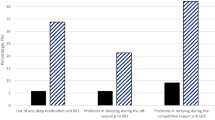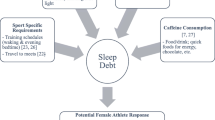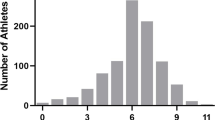Abstract
Sleep, body composition and dietary intake are crucial for athletes’ health and performance but have never been investigated in acrobatic gymnasts. Thus, this study aimed to evaluate sleep, body composition, dietary intake and eating behaviours of acrobatic gymnasts. Using a cross-sectional study, 82 Portuguese acrobatic gymnasts (12.8 ± 3.1 years, 61 females and 21 males) were evaluated during the competitive period to collect training data, sleep duration, body composition, dietary intake and eating behaviours before, during and after practices. Most of the gymnasts (91.5%) slept less than 8 h/night. Female adolescents slept significantly less on weekdays than female children (P = 0.024). Female adolescents’ mean body mass was below the normal and 60.0% showed menstrual irregularities; 4.9% of females bases were overweight and 2.4% obese. Male adolescents slept significantly less on weekdays than male children (P = 0.001); significant differences were shown for fat-free mass (P = 0.014); however, 3.7% were overweight. All daily energy and macronutrient intakes were significantly different according to age and gender, with exception for fibre and energy intake in females (P = 0.057 and P = 0.052, respectively), and for protein in males (P = 0.068). Female and male adolescents demonstrated significant lower energy availability (32.8 ± 9.4 kcal/kg FFM/day and 45.1 ± 14.7 kcal/kg FFM/day) than children (45.8 ± 8.7 kcal/kg FFM/day and 53.8 ± 9.1 kcal/kg FFM/day), respectively. Significant low intakes of important vitamins and minerals were reported. Most of the participants did not eat or drink during or immediately after training sessions.
Conclusion: Acrobatic gymnasts revealed low BF, short sleep duration and macro- and micronutrients inadequate intakes. The Female Athlete Triad was demonstrated by female adolescent gymnasts.
What is Known: • Adequate dietary intake is an important resource for athletes’ short and long-term health and performance. • There are no published studies in acrobatic gymnasts’ sleep, body composition or dietary intake. |
What is New: • This study provides the first data on significant differences in energy intake and availability between acrobatic gymnasts; overweight and obesity were present in females. • Macro and micronutrients were inappropriate. Female Athlete Triad was observed in female adolescent acrobatic gymnasts. |
Similar content being viewed by others
Abbreviations
- ACRO:
-
Acrobatic gymnastics
- ACSM:
-
American College of Sports Medicine
- BMR:
-
Basal metabolic rate
- BF:
-
Body fat
- BM:
-
Body mass
- BMI:
-
Body mass index
- EA:
-
Energy availability
- EI:
-
Energy intake
- EEE:
-
Exercise energy expenditure
- FFM:
-
Fat-free mass
- FIG:
-
Fédération Internationale de Gymnastique
- FNB/IM:
-
Food and Nutrition Board/Institute of Medicine
- LEA:
-
Low energy availability
- RDA:
-
Recommended Dietary Allowances
- TBW:
-
Total body water
References
Ainsworth BE, Haskell WL, Herrmann SD, Meckes N, Bassett DR Jr, Tudor-Locke C, Greer JL, Vezina J, Whitt-Glover MC, Leon AS (2011) Compendium of physical activities: a second update of codes and MET values. Med Sci Sports Exerc 43(8):1575–1581. https://doi.org/10.1249/MSS.0b013e31821ece12
American Society for Reproductive Medicine (2008) Current evaluation of amenorrhea. Fertil Steril 90(5s):s219–s225. https://doi.org/10.1016/j.fertnstert.2008.08.038
Brozek J, Grande F, Anderson JT, Keys A (1963) Densitometric analysis of body composition: revision of some quantitative assumptions. Ann N Y Acad Sci 26(110):113–140
Croezen S, Visscher TL, Ter Bogt NC, Veling ML, Haveman-Nies A (2009) Skipping breakfast, alcohol consumption and physical inactivity as risk factors for overweight and obesity in adolescents: results of the E-MOVO project. Eur J Clin Nutr 63:405–412. https://doi.org/10.1038/sj.ejcn.1602950
Cunningham JJ (1980) A reanalysis of the factors influencing basal metabolic rate in normal adults. Am J Clin Nutr 33:2372–2374
De Souza MJ, Nattiv A, Joy E et al (2014) 2014 female athlete triad coalition consensus statement on treatment and return to play of the female athlete triad: 1st international conference held in San Francisco, CA, May 2012, and 2nd international conference held in Indianapolis, IN, May 2013. Clin J Sport Med 24(2):96–119. https://doi.org/10.1097/JSM.0000000000000085
Delaney JA, Thornton HR, Scott TJ, Ballard DA, Duthie GM, Wood LG, Dascombe BJ (2016) Validity of skinfold-based measures for tracking changes in body composition in professional rugby league players. Int J Sports Physiol Perform 11(2):261–266. https://doi.org/10.1123/ijspp.2015-0244
Floría P, Gómez-Landero LA, Harrison AJ (2015) Centre of pressure correlates with pyramid performance in acrobatic gymnastics. Sports Biomech 14(4):424–434. https://doi.org/10.1080/14763141.2015.1084032
Fullagar HH, Skorski S, Duffield R, Hammes D, Coutts AJ, Meyer T (2015) Sleep and athletic performance: the effects of sleep loss on exercise performance, and physiological and cognitive responses to exercise. Sports Med 45:161–186. https://doi.org/10.1007/s40279-014-0260-0
Goldberg GR, Black AE, Jebb SA, Cole TJ, Murgatroyd PR, Coward WA, Prentice AM (1991) Critical evaluation of energy intake data using fundamental principles of energy physiology: 1. Derivation of cut-off limits to identify under-recording. Eur J Clin Nutr 45:569–581
Grapton X, Lion A, Gauchard GC, Barrault D, Perrin PP (2013) Specific injuries induced by the practice of trampoline, tumbling and acrobatic gymnastics. Knee Surg Sports Traumatol Arthrosc 21(2):494–499. https://doi.org/10.1007/s00167-012-1982-x
Halson SL (2014) Sleep in elite athletes and nutritional interventions to enhance sleep. Sports Med 44:S13–S23. https://doi.org/10.1007/s40279-014-0147-0
Hoch AZ, Pajewski NM, Moraski L, Carrera GF, Wilson CR, Hoffmann RG, Schimke JE, Gutterman DD (2009) Prevalence of the female athlete triad in high school athletes and sedentary students. Clin J Sport Med 19(5):421–428. https://doi.org/10.1097/JSM.0b013e3181b8c136
Jeukendrup A, Cronin L (2011) Environmental factors affecting elite young athletes. Med Sport Sci 56:47–58. https://doi.org/10.1159/000320646
Jonnalagadda SS, Bernadot D, Nelson M (1998) Energy and nutrient intakes of the United States national women,s artistic gymnastics team. Int J Sport Nutr 8(4):331–344
Kant AK, Graubard BI, Atchison EA (2009) Intakes of plain water, moisture in foods and beverages, and total water in the adult US population—nutritional, meal pattern, and body weight correlates: National Health and nutrition examination surveys 1999–2006. Am J Clin Nutr 90:655–663
Malik VS, Schulze MB, Hu FB (2006) Intake of sugar sweetened beverages and weight gain: a systematic review. Am J Clin Nutr 84:274–288
Marfell-Jones M (2006) International standards for anthropometric assessment. Potchefsroom, South Africa, ISAK
Maslowsky J, Ozer EJ (2014) Developmental trends in sleep duration in adolescence and young adulthood: evidence from a national United States sample. J Adolesc Health 54:691–697. https://doi.org/10.1016/j.jadohealth.2013.10.201
Michopoulou E, Avloniti A, Kambas A, Leontsini D, Michalopoulou M, Tournis S, Fatouros IG (2011) Elite premenarcheal rhythmic gymnasts demonstrate energy and dietary intake deficiencies during periods of intense training. Pediatr Exerc Sci 23(4):560–572
Nattiv A, Loucks AB, Manore MM, Sandorn CF, Sundgot-Borgen J, Warren MP, American College of Sport Medicine (2007) American College of Sport Medicine position stand. The female athlete triad. Med Sci Sports Exerc 39:1867–1882
Padez C, Rocha MA (2003) Age at menarche in Coimbra (Portugal) school girls: a note on the secular changes. Ann Hum Biol 30(5):622–632
Portuguese Directorate-General of Health (2006) Child and juvenile health surveillance consultations—update of growth curves [in Portuguese]. Portuguese Directorate-General of Health - Ministry of Health, Lisbon
Poslusna K, Ruprich J, de Vries JH, Jakubikova M, van't Veer P (2009) Misreporting of energy and micronutrient intake estimated by food records and 24 hour recalls, control and adjustment methods in practice. Br J Nutr 101:S73–S85. https://doi.org/10.1017/S0007114509990602
Purnell M, Shirley D, Nicholson L, Adams R (2010) Acrobatic gymnastics injury: occurrence, site and training risk factors. Phys Ther Sport 11(2):40–46. https://doi.org/10.1016/j.ptsp.2010.01.002
Rodriguez NR, DiMarco NM, Langley S, American Dietetic Association, Dietitians of Canada, American College of Sports Medicine (2009) Position of the American Dietetic Association, Dietitians of Canada and the American College of Sports Medicine: Nutrition and Athletic Performance. J Am Diet Assoc 109:509–527. https://doi.org/10.1016/j.jada.2009.01.005
Sargent C, Lastella M, Halson SL, Roach GD (2014) The impact of training schedules on the sleep and fatigue of elite athletes. Chronobiol Int 31:1160–1168. https://doi.org/10.3109/07420528.20149.57306
Sartor F, Capuzzoni S, Rospo G, La Torre A, Vailati F, Vailati E (2017) Influence of competition day on cognitive control and HRV in young male gymnasts. J Strength Cond Res 31(7):1982–1993. https://doi.org/10.1519/JSC.0000000000001652
Shei RJ, Lindley MR, Mickleborough TD (2014) Omega-3 polyunsaturated fatty acids in the optimization of physical performance. Mil Med 179S:144–156. https://doi.org/10.7205/MILMED-D-14-00160
Silva M-R G, Paiva T (2015) Low energy availability and low body fat of female gymnasts before an international competition. Eur J Sport Sci 16:1–9. https://doi.org/10.1080/17461391.2014.969323
Silva M-RG, Paiva T (2015) Poor precompetitive sleep habits, nutrients’ deficiencies, inappropriate body composition and athletic performance in elite gymnasts. Eur J Sport Sci 27:1–10. https://doi.org/10.1080/17461391.2015.1103316
Silva M-R G, Pascoal A, Silva HH, Paiva T (2016) Assessing sleep, travelling habits and jet-lag in kite surfers according to competition level. Biol Rhythm Res. https://doi.org/10.1080/09291016.2016.1181233
Silva M-RG, Santos-Rocha R, Barata P, Saavedra F (2017) Gender inequalities in Portuguese gymnasts between 2012 and 2016. Sci Gymnastics 9(2):191–200
Silva M-RG, Silva HH (2017) Comparison of body composition and nutrients’ deficiencies between Portuguese rink-hockey players. Eur J Pediatr 176(1):41–50. https://doi.org/10.1007/s00431-016-2803-x
Soric M, Misigoj-Durakovic M, Pedisic Z (2008) Dietary intake and body composition of prepubescent female aesthetic athletes. Int J Sport Nutr Exerc Metab 18(3):343–354
Taboada-Iglesias Y, Gutiérrez-Sánchez Á, Vernetta Santana M (2016) Anthropometric profile of elite acrobatic gymnasts and prediction of role performance. J Sports Med Phys Fitness 56(4):433–442
Tenforde AS, Barrack MT, Nattiv A, Fredericson M (2016) Parallels with the female athlete triad in male athletes. Sports Med 46(2):171–182. https://doi.org/10.1007/s40279-015-0411-y.38
Thorland WG, Johnson GO, Tharp GD, Housh TJ, Cisar CJ (1984) Estimation of body density in adolescent athletes. Hum Biol 56(3):439–448
Acknowledgements
The authors thank the gymnasts for their participation in this study and coaches and parents for their collaboration. This study was carried out at the Faculty of Health Sciences, University Fernando Pessoa, Oporto, Portugal and at the Research Centre of Anthropology and Health, University of Coimbra, Coimbra, Portugal. This work was supported by National Founds from FCT – Foundation for Science and Technology under Grant: PEst-OE/SADG/UI0283/2015. The authors declare no conflict of interest.
Funding sources
This work was supported by National Founds from FCT – Foundation for Science and Technology [grant number: PEst-OE/SADG/UI0283/2015].
Author information
Authors and Affiliations
Contributions
All authors were responsible for the conception, design, data analysis and data interpretation of the study and writing of the manuscript; M.-R. G. Silva was also responsible for data collection. All authors approved the final version of the manuscript.
Corresponding author
Ethics declarations
Informed written consent from each participant was obtained in accordance with the principles expressed in the Declaration of Helsinki guidelines for human subjects. The current study was reviewed and approved by the Ethical Committee of the University Fernando Pessoa (Oporto, Portugal). All procedures performed in studies involving human participants were in accordance with the ethical standards of the institutional and/or national research committee and with the 1964 Helsinki Declaration and its later amendments or comparable ethical standards.
Conflict of interests
The authors declare that they have no conflict of interest.
Informed consent
Informed consent was obtained from all individual participants included in the study.
Additional information
Communicated by Mario Bianchetti
Rights and permissions
About this article
Cite this article
Silva, MR.G., Silva, HH. & Paiva, T. Sleep duration, body composition, dietary profile and eating behaviours among children and adolescents: a comparison between Portuguese acrobatic gymnasts. Eur J Pediatr 177, 815–825 (2018). https://doi.org/10.1007/s00431-018-3124-z
Received:
Revised:
Accepted:
Published:
Issue Date:
DOI: https://doi.org/10.1007/s00431-018-3124-z




